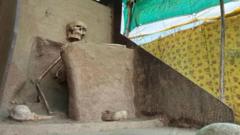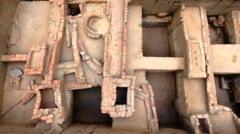The remarkable saga of a 1,000-year-old skeleton in India has finally taken a positive turn as it has been relocated to a local museum in Vadnagar, six years after its discovery. Initially unearthed in 2019, the skeleton had been kept in a tarpaulin shelter exposed to the elements due to bureaucratic disputes regarding its custody.
Recently, the skeleton was carefully transported to the Archaeological Experiential Museum, just a few miles from the excavation site. Mahendra Surela, the museum curator, stated that experts supervised the transport process to ensure its safety. The skeleton is currently displayed next to the reception area, secured by a protective barrier, while officials from the Archaeological Survey of India are determining a permanent display setup.
Archaeologist Abhijit Ambekar, who made the discovery, expressed his delight at the increased attention the skeleton is finally receiving. Experts believe the remains date back to the Solanki period, which spanned from 940 to 1300 CE. The better preservation of the skeleton is credited to the undisturbed soil around it. Ambekar highlighted the skeleton's importance in understanding "samadhi burials," an ancient Hindu practice of interring revered individuals instead of cremating them, emphasizing the cultural significance of this find.
Recently, the skeleton was carefully transported to the Archaeological Experiential Museum, just a few miles from the excavation site. Mahendra Surela, the museum curator, stated that experts supervised the transport process to ensure its safety. The skeleton is currently displayed next to the reception area, secured by a protective barrier, while officials from the Archaeological Survey of India are determining a permanent display setup.
Archaeologist Abhijit Ambekar, who made the discovery, expressed his delight at the increased attention the skeleton is finally receiving. Experts believe the remains date back to the Solanki period, which spanned from 940 to 1300 CE. The better preservation of the skeleton is credited to the undisturbed soil around it. Ambekar highlighted the skeleton's importance in understanding "samadhi burials," an ancient Hindu practice of interring revered individuals instead of cremating them, emphasizing the cultural significance of this find.





















